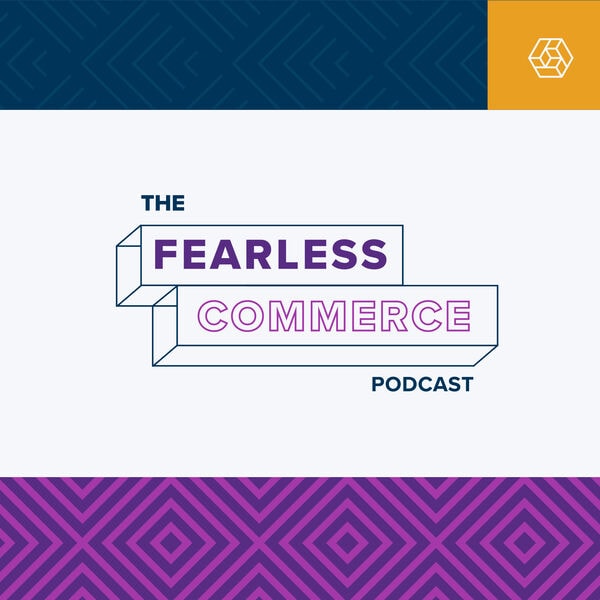In this episode of The Fearless Commerce Podcast, co-hosts Adam Silverman and Mike Cassidy speak with Brendan Witcher, VP and principal analyst at Forrester Research.
Reviewed, revised and approved by Signifyd humans.
From the bustling lanes of ecommerce and the evolution of brick-and-mortar stores to the nuances of strategic planning in a constantly evolving market, this episode explores the currents and undercurrents of modern retail. As industry giants reshape retail of the future, where does that leave smaller retailers? And what does it truly mean to be fearless in today’s commercial age? Join us as we dissect these questions and more, offering insights that are as profound as they are practical. The summary below is not a verbatim transcript.
Podcast chapters
Introduction: Meet Brendan Witcher of Forrester Research
As we begin, Witcher shares his journey from working in retail at Harry & David as a buyer, transitioning into inventory planning due to his aptitude for numbers, and ultimately landing in marketing as ecommerce began aligning with it. He recalls being recruited to Guitar Center for strategic planning, emphasizing that while he wasn’t formally in charge of ecommerce, he led digital initiatives to impact the organization’s growth. An essential experience for Brendan was evaluating ecommerce platforms, weighing on-premise against cloud solutions, and understanding their comprehensive costs. As digital avenues expanded, Brendan’s involvement grew organically, exposing him to various facets of the digital realm.
What is the future of Ecommerce?
Noting that while he’s bound by NDAs with many retailers, he shares overarching trends without specific brand references. A few years ago, the focus was on using fulfillment as a differentiator. Currently, there’s a growing interest in introducing commerce in unexpected areas like Tesla charging stations, virtual assistant devices, and beyond. A notable trend is inline commerce, which involves integrating purchasing opportunities directly within a user’s current activity to reduce friction. For example, directly buying a recommended knee brace during a virtual doctor’s appointment or purchasing gifts while accepting an event invitation. With the proliferation of digital tools and platforms, from dating to yoga classes, there’s a growing opportunity to weave commerce seamlessly into these activities. While travel and hospitality sectors are pioneering this approach, many industries are now testing these waters, discerning the right channels for such integrations.
Is the retail industry growing or declining?
Let’s turn to the current state and potential future of physical retail stores. Witcher is not a staunch advocate for physical stores but recognizes their significance. Despite the surge in ecommerce during the pandemic, approximately 75% of retail sales still occur in brick-and-mortar settings. However, the distinction between ecommerce and in-store sales is blurring, especially with the rise of omnichannel sales and options like “buy online, pick up in store.” How retailers account for these sales varies, with some attributing them to their physical stores due to the inventory and labor costs, while others categorize them as ecommerce sales to boost their stock prices.
Reflecting on a past project, Witcher mentions an intriguing experiment where retail industry professionals imagined creating a physical store from scratch in today’s digital age. They identified 42 different ways in which modern stores fail to optimize retail operations or cater to contemporary customer expectations based on their digital shopping experiences. The primary takeaway was that traditional stores were designed for a single shopping experience: selecting an item, paying at the cashier, and leaving. Any deviation from this process meant the store is not optimized for that mode of shopping.
He emphasizes the need for adaptation, pointing out that while media-driven narratives like the “retail apocalypse” have waned, it’s evident that even pure ecommerce brands like Warby Parker are venturing into physical retail to tap into a larger customer base.
How did COVID affect the retail industry?
The discussion turns to the impact of the pandemic on retail, especially ecommerce. One narrative that emerged during COVID was that large retailers thrived during this period — a case of the rich got richer”. Witcher observes that while some small retailers also saw growth, it was nothing like the growth experienced by giants like Walmart and Amazon.
Witcher elaborates on several reasons for this shift:
- Love for aggregators: Humans have a natural inclination towards aggregators – platforms that bring together multiple offerings under one roof. Examples include TripAdvisor, Yelp and travel websites. Especially during stressful times like the pandemic, people preferred a one-stop-shop experience, avoiding the hassle of visiting numerous individual sites.
- Ease and convenience: During the pandemic, there was a massive shift to online shopping. Target, for instance, reported that they had three million new customers visiting their website within a quarter, a figure that surprised many.
- Building habitual buyers: Once these new customers started shopping, large retailers invested heavily in marketing strategies to transform these one-time buyers into habitual ones. The goal was to inculcate a shopping routine so that these customers would continuously return to their platforms.
- Limited options: Due to the pandemic restrictions, many smaller stores had to shut down, leaving consumers with limited shopping options. This naturally led them to turn to the larger retailers that remained operational.
- Essential vs. non-essential: During the lockdowns, only businesses deemed “essential” were allowed to remain open. This classification led to a surge in customers for businesses that fell under the essential category and was a setback for those that didn’t. Witcher mentions the controversy surrounding GameStop, which claimed to be an “essential business,” which worked out poorly for the company.
In essence, the convergence of these factors, combined with the pandemic’s constraints, significantly contributed to the enormous growth witnessed by major retailers.
How can smaller retailers be future-proof?
Smaller retailers might face challenges in ecommerce, given the dominance of big retailers. Many large retailers have a fixed mindset, often overlooking niche solutions that cater to specific customer needs. For instance, when considering in-store virtual makeup trials, a service offered by Sephora, a large retailer was dismissive because such a solution didn’t cater to all their departments. This mindset contrasts with smaller retailers, who have the opportunity to innovate by addressing specific customer pain points.
A crucial topic in the retail industry now is the future of fraud and payments. One company with 44,000 locations in APAC was banking on credit cards being the main payment method for the next decade. However, the future is uncertain, with potential payment technologies like biometrics, voice payments or computer vision. It’s risky to base a long-term strategy solely on current payment methods, like credit cards. Retailers need to be adaptable, considering the fast-paced changes in payment methods and do as much as they can to future-proof their businesses.
Consider, for instance, a future that includes seamless retail experiences, such as ordering from Starbucks while at a Tesla charging station. That sort of possibility indicates the importance of integrating and evolving with technology.
The importance of planning ahead for retail success
Strategy work in ecommerce and business is intricate and requires anticipating various outcomes. Businesses should avoid the “we’ll cross that bridge when we come to it” attitude. Instead, they should have contingency plans for different scenarios. The “fail fast” approach can be imprudent, especially when introducing major strategies like store designs or membership programs. Moving fast is less crucial than moving in the right direction. Many companies, aside from giants like Walmart and Amazon, don’t have the financial cushion to afford mistakes. Therefore, planning for variables in advance is essential. Changing minor elements, like a buy button’s color, can be done quickly, but significant strategies demand more foresight. Hasty decisions can lead to costly repercussions, like technical debt. Investing extra effort in strategic thinking is essential.
What does being fearless mean to you?
The conversation turns to the topic of being fearless in commerce. Witcher highlights the myth of differentiated customer experiences in ecommerce, arguing that most are similar and undistinguished. The concept of fearless commerce is discussed, suggesting it’s about challenging well-known status quos and looking beyond typical practices in the industry. Being fearless doesn’t imply a lack of fear, but acting despite it. Witcher points out that many retailers believe they’re creating unique experiences, but in reality, their websites and strategies are quite similar to others. He highlights the misconception that customers want a relationship with brands when in reality, most just want to buy their products and move on. The conversation also touches on the notion that companies are more company-obsessed than customer-obsessed, building strategies based on myths.
Lastly, there’s emphasis on the importance of always questioning strategies and beliefs, and the dangers of strategic laziness. Witcher emphasizes the need to recognize bad strategies and biases. And he touches on the impacts of not being proactive in strategic planning. The idea is to help organizations see different perspectives and guide them in the right direction.











